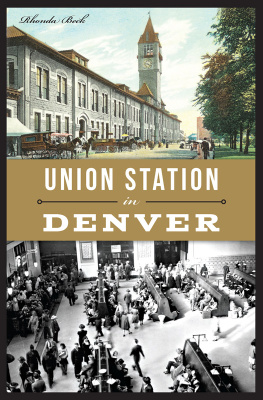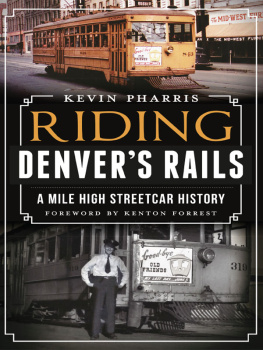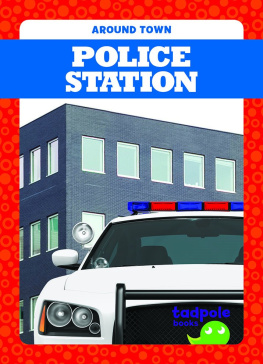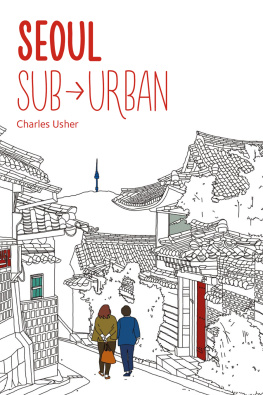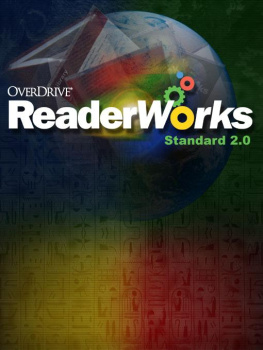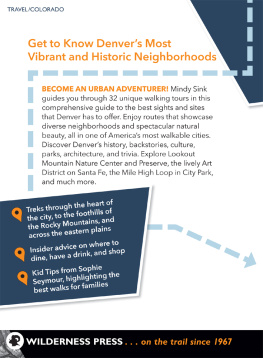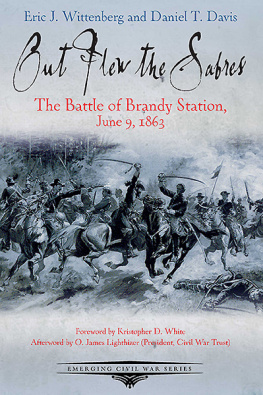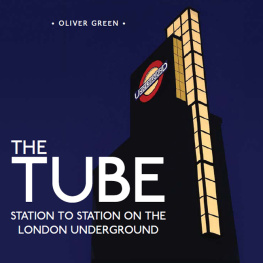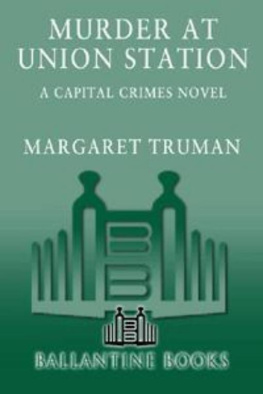

Published by The History Press
Charleston, SC
www.historypress.net
Copyright 2016 by Rhonda Beck
All rights reserved
First published 2016
e-book edition 2016
ISBN 978.1.62585.494.0
Library of Congress Control Number: 2015955230
print edition ISBN 978.1.62619.964.4
Notice: The information in this book is true and complete to the best of our knowledge. It is offered without guarantee on the part of the author or The History Press. The author and The History Press disclaim all liability in connection with the use of this book.
All rights reserved. No part of this book may be reproduced or transmitted in any form whatsoever without prior written permission from the publisher except in the case of brief quotations embodied in critical articles and reviews.
Union Station served as the heart of Denver from opening day in 1881 until its eclipse by automobiles and aviation. Rhonda Beck tells the heartening story of Union Stations resurrection.
Professor Tom Dr. Colorado Noel
CONTENTS
FOREWORD
To tell the story of Union Station, you need to look at the entire core of Denvers downtown and its transformation since the 1980s.
Today, the downtown area is envied by cities nationwide because of the established housing, restaurants, bars and businesses with nearby amenities of sports, art, music and flourishing city parks. But thirty-five years ago, the Central Platte Valley just west of downtown was littered with abandoned railroad yards, decaying buildings and open space often filled with trash and homeless camps.
And among the neglect to the east in Lower Downtown (LoDo) was the once vibrant Union Station depot, which played such a vital role in the history of the railroad in the Mile High City.
Mayor Federico Pea began the cleanup of the area in the 1980s, when he served two terms as Denvers first Latino mayor with the motto: Imagine a Great City. When I was elected in 1991 as the citys first African American mayor, my goal for the valley and downtown was to build that great city.
I knew the first place to start was with our struggling downtown, where most businesses closed their doors at 5:00 p.m. My first official action as mayor was to call for a Downtown Economic Summit. We gathered property owners, store owners, individuals with leases and others interested in revitalizing downtown.
We worked on the issues of how to keep downtown safe, how to deal with cleanliness and how to attract new residents. I knew once we attracted new housing, the businesses would come. In 1990, there were 2,700 residences downtown. That had ballooned to about 8,000 by the time I left office after three terms in 2003.
While we first focused on attracting new housing, we also knew downtown needed to have amenities to attract more visitors.
Other projects that affected the downtown area were cleaning up the South Platte River and replacing the nearby wasteland with ninety acres of new city parks, including Confluence, Cuernavaca and the thirty-acre centerpiece, Commons Park. Additionally, the city, in partnership with developers constructing new housing in the Central Platte Valley, built the $3 million Millennium Bridge to connect the valley with downtown.
I also made sure that the citys professional sports teamsthe Denver Broncos, Denver Nuggets and Colorado Avalanchesigned contracts to stay in the Platte Valley for at least twenty years. And we passed bonds to raise money to improve the Denver Art Museum and Colorado Convention Center, in addition to getting the new Hilton Hotel built.
And in 1995, Coors Field opened as the home of the Colorado Rockies, which spurred more housing and business development in other abandoned industrial areas.
While these projects were underway, I also knew we had to find a way to bring the Union Station depot back to life. The wonderful historic building needed to return to the transportation hub it once was, and my administration began that work.
We spent several years working with the Regional Transportation District (RTD) to relocate the bus terminal from the Sixteenth Street Mall to Union Station. To allow that to happen, RTD had to purchase the depot from a private developer. When RTD came up short for the $60 million purchasing price, I worked with city staff to find an additional $7 million to allow the transaction to be completed.
My administration, including chief of staff Wayne Cauthen and the late Jennifer Moulton, my planning director, helped get all the pieces in place for the depot to be revitalized.
I felt proud to see the seeds of the project finally come to fruition in 2014 at the ribbon-cutting for the $300 million renovation. Union Station is once again a jewel for the Mile High City.
There also is a personal aspect of my desire to preserve Union Station. The railroad has been a continuous part of my life, from my father, Marion Wellington Webb, working for the Chicago and North Western Railroad for forty-two years to my travels by train when time allows. It is a wonderful way to see the country.
I applaud author Rhonda Beck for her research, interviews and writing. It is not easy to condense more than one hundred years of history into a book. She has successfully informed generations of readers about the birth and rebirth of Union Station.
Much like traveling by train, readers will enjoy weaving through the journey of how the station has survived fire, relocation, blizzards, storms, two world wars, neglect and its final destination of revitalization.
WELLINGTON E. WEBB
Denvers mayor, 19912003
ACKNOWLEDGEMENTS
There are many to whom I owe gratitude:
Tom Noel, Dr. Colorado, for suggesting I should take on this project. Thank you for believing in me.
Authors Charles Abi and Kenton Forrest, whose book Denvers Railroads: The Story of Union Station and Railroads of Denver was my bible for the original stations history, and again to Charles Albi, for his support, manuscript review and encouragement.
Fellow postcard collector and friend Bill Eloe, for allowing me to scan and publish his rare Jackson and Alex Martin stereo cards.
Author and dear friend Beth Sagsetter, for her proposal and marketing ideas and support throughout the entire project; along with her husband, Bill, she drew me in and taught me so much about Colorados mining history, inspiring me to continue researching this states rich past. Beth, please accept my greatest appreciation and thanks for the inspiring conclusion of this story. The Sagsetters are authors of The Mining Camps Speak; The Cliff Dwellings Speak; and Side by Side: A History of Denvers Cofield Historic District and owners of Benchmark Publishing of Colorado.
Krista Slavicek, acquisitions editor at The History Press, who patiently worked with me to submit the images and manuscript and finish this project.
Becky LeJeune, commissioning editor at The History Press, who was a delight to work with during the proposal phase of this adventure.
A friend of many years, Lola Wilcox of White Raven Enterprises, Ltd., for manuscript review and for always encouraging me in any endeavor Ive taken on.
All the wonderfully helpful soles at the Western History Department of the Denver Public Library and especially Bruce Hanson, although now retired, and Roger Dudley, who always were enthusiastic about my historic research and ephemeral finds.
Kate Davis of Sage Hospitality, for sharing the beautiful construction photo gallery by Ellen Jaskol Photography and escorting me and Gary Hubel into the non-public places for opportunities to photograph some of the wonderful hidden treasures of Union Station.
Next page
